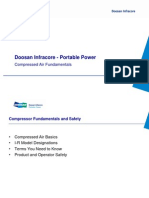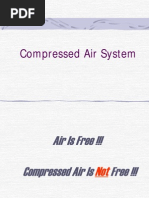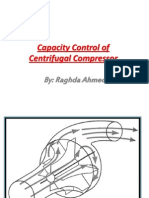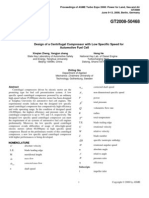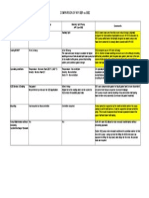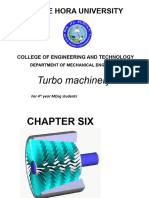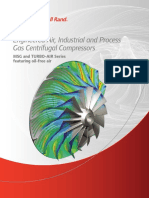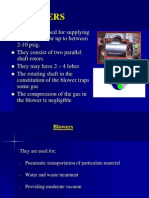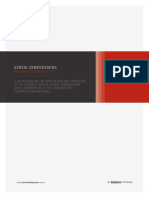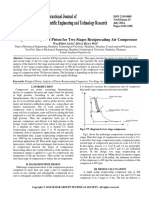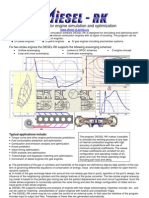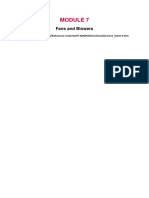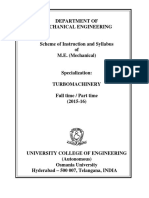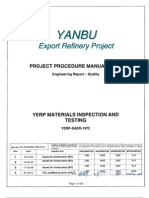0 ratings0% found this document useful (0 votes)
490 viewsCentrifugal Compressor Tutorial
Centrifugal Compressor Tutorial
Uploaded by
JackjinnThis software system called CompAero contains several programs for designing and analyzing centrifugal and axial flow compressors. The main programs allow for preliminary stage design, detailed component design, performance analysis, and flow analysis. CompAero implements methods from two books on compressor design and uses an equation of state package for thermodynamic property calculations of gases and mixtures.
Copyright:
© All Rights Reserved
Available Formats
Download as PDF, TXT or read online from Scribd
Centrifugal Compressor Tutorial
Centrifugal Compressor Tutorial
Uploaded by
Jackjinn0 ratings0% found this document useful (0 votes)
490 views31 pagesThis software system called CompAero contains several programs for designing and analyzing centrifugal and axial flow compressors. The main programs allow for preliminary stage design, detailed component design, performance analysis, and flow analysis. CompAero implements methods from two books on compressor design and uses an equation of state package for thermodynamic property calculations of gases and mixtures.
Original Description:
Centrifugal Compressor Tutorial
Copyright
© © All Rights Reserved
Available Formats
PDF, TXT or read online from Scribd
Share this document
Did you find this document useful?
Is this content inappropriate?
This software system called CompAero contains several programs for designing and analyzing centrifugal and axial flow compressors. The main programs allow for preliminary stage design, detailed component design, performance analysis, and flow analysis. CompAero implements methods from two books on compressor design and uses an equation of state package for thermodynamic property calculations of gases and mixtures.
Copyright:
© All Rights Reserved
Available Formats
Download as PDF, TXT or read online from Scribd
Download as pdf or txt
0 ratings0% found this document useful (0 votes)
490 views31 pagesCentrifugal Compressor Tutorial
Centrifugal Compressor Tutorial
Uploaded by
JackjinnThis software system called CompAero contains several programs for designing and analyzing centrifugal and axial flow compressors. The main programs allow for preliminary stage design, detailed component design, performance analysis, and flow analysis. CompAero implements methods from two books on compressor design and uses an equation of state package for thermodynamic property calculations of gases and mixtures.
Copyright:
© All Rights Reserved
Available Formats
Download as PDF, TXT or read online from Scribd
Download as pdf or txt
You are on page 1of 31
CENTRIFUGAL COMPRESSOR AERODYNAMIC
DESIGN AND ANALYSIS USING COMPAERO
CompAero is an aerodynamic design and analysis software system for centrifugal
and axial-flow compressors for personal computers. It implements methods
described in the following two books:
Aungier, R. H., Centrifugal Compressors: A Strategy
for Aerodynamic Design and Analysis (ASME Press,
New York, 2000)
Aungier, R. H., Axial-Flow Compressors: A Strategy for
Aerodynamic Design and Analysis (ASME Press, New
York, 2003)
Note: a users guide (CompAero.pdf) will be installed with the software to bridge the
gap between these books and the CompAero software system.
By Ronald H. Aungier
September 14, 2011
1
OVERVIEW OF THE PROGRAMS IN COMPAERO
COMPAERO: a menu program to control the system and conveniently navigate among the other programs.
SIZE: a centrifugal compressor stage preliminary aerodynamic design program.
CENCOM: an aerodynamic performance analysis for single-stage or multistage centrifugal compressors.
GASPATH: a general gas path (end-wall contours and blades) design program.
VLDESIGN: a vaneless diffuser detailed aerodynamic design and performance analysis program.
VDDESIGN: a vaned diffuser detailed aerodynamic design, performance analysis and blade-to-blade flow
analysis program.
RCDESIGN: a crossover-bend and return channel detailed aerodynamic design, performance analysis and blade-
to-blade flow analysis program.
FLOW3D: a quasi-three-dimensional inviscid flow field analysis and surface boundary layer analyses.
B2B2D: a two-dimensional blade-to-blade potential flow analysis with supporting boundary layer analysis.
TDB2B: a time-marching blade-to-blade flow analysis with supporting boundary layer analysis.
RKMOD: an ideal/non-ideal fluid equation-of-state package for a variety of thermodynamic property calculations
(this equation of state is used by many of the other programs).
GASDATA: a gas property database maintenance program to support RKMOD and the other programs that use
its equation of state (including a current database of over 100 compounds).
RIGPAC: (Radial Impeller Geometry PACkage): a general geometry package primarily for impellers, but suitable
for other vaned components also. It performs many operations and geometry calculations commonly used in
centrifugal compressor design and implementation (e.g., scaling, tip trims, imposing new profiles for different
capacities, etc.). Conceptually, it is similar to GASPATH, except that it starts from known geometry. Hence, it is
often used to introduce existing component designs into the COMPAERO system to apply the other programs
for troubleshooting or upgrade activity.
BEZIER: a program to generate the curves used by GASPATH to construct the end-wall contours and blades.
AXCOM: an aerodynamic performance analysis for single-stage or multistage axial-flow compressors.
AXSTAGE: an axial-flow compressor stage design program.
AXDESIGN: a multistage axial-flow compressor design program.
EXHAUST: an exhaust diffuser aerodynamic performance analysis (including a scroll or collector).
BLADE: a blade-section geometry program for the various standard axial-flow compressor airfoils.
VOLUTE: a detailed geometry design program for volutes in radial turbomachinery.
PTC10: corrects compressor test performance data to design conditions per ASME PTC 10-1997.
2
USING THE COMPAERO MENU PROGRAM
The Menu Program (Compaero.exe) Is Highly Recommended.
It Simplifies The Navigation Among Programs Required For Design & Analysis.
It Offers Several Taskbar Styles And Startup Options To Suit User Preferences.
Typically, The Menu Program Is Launched From A Shortcut On Your Desktop.
The Picture Below Shows The Balanced Rows & Columns Taskbar Style.
3
INPUT & OUTPUT UNITS FOR COMPAERO PROGRAMS
Programs That Use Dimensional Data Offer A Wide Range Of Input/Output Units.
A Default Set Of Units (Defined By The User) Is Assumed For New Problems.
The User Can Change The Units Used For Any Problem As Appropriate.
Actual Units Used Are Always Saved In The Input Files For Use On Future Runs.
Caution: Changing The Units Does Not Convert Input Data Already Loaded.
To Set The Input/Output Units, First Select A Basic Set From The Choices Below.
4
INPUT & OUTPUT UNITS, CONTINUED
Then, You Can Customize Individual Units From The Dropdown Lists Below.
Note That Some Units Are Derived From Your Specified Units.
5
IDEAL & NON-IDEAL FLUID EQUATION-OF-STATE PACKAGE
Available Models:
Aungiers Modified Redlich-Kwong Equation Of State.
Original Redlich-Kwong Equation Of State.
Ideal (Thermally Perfect) Gas Equation Of State.
Pseudo-Perfect Gas Equation Of State.
Applicable To Pure Fluids And Fluid Mixtures.
In General, Compressor Programs Are Valid For The Vapor Phase Only. RKMOD
Can Handle Two-Phase Flows For Phase Checking, Liquid Knockout, Etc.
GASDATA Contains An Initial Gas Property Database (Over 100 Compounds) To
Get Users Started. But No Gas Property Database Can Be Accurate For All
Possible Applications. Users Are Responsible For Establishing A Database
Suitable For Their Applications.
Some Good Sources Of Gas Property Data For CompAero Are:
Ried, R. C., Prausnitz, J. M., and Sherwood, T. K., The Properties Of Gases And
Liquids (McGraw-Hill, New York, 1977).
Ried, R. C., Prausnitz, J. M. and Poling, B. E., The Properties Of Gases And
Liquids, Fourth edition (McGraw-Hill, New York, 1987).
Yaws, C. L., Chemical Properties Handbook (McGraw-Hill, New York, 1999).
6
NON-IDEAL GAS EQUATION-OF-STATE ACCURACY
Accuracy Is Quite Sufficient For All Aerodynamic Design And Analysis Activity.
Aungiers Modified Redlich-Kwong Equation Of State Is The Better Choice.
These Equations Of State Are Not Recommended For Critical Applications Such As
Performance Test Data Reduction Or Low-Tolerance Performance Guarantees.
The Figures Below Compare Predictions With Experiment For Commonly-Used
Compounds Over a Wide Range Of Pressure, Temperature And Acentric Factor.
COMPOUND
Ammonia 0.2550
Carbon Dioxide 0.2250
Ethylene 0.0868
Helium -0.464
Hydrogen -0.220
I-Butane 0.1848
Methane 0.0080
N-Pentane 0.2539
Nitrogen 0.0400
Propane 0.1520
Refrigerant R134a 0.3254
Steam 0.3440
7
SELECTING COMPONENTS FOR A GAS MIXTURE
Double-Click A Compound To Add It To The Mixture.
Double-Click Cancel When The Mixture Definition Is Complete.
8
SPECIFYING COMPOUND MOLE FRACTIONS FOR A MIXTURE
Enter The Mole Fraction Of Each Compound In The Mixture
The Programs Will Let You Edit These Values Later If Needed.
The Programs Always Normalize The Sum Of The Mole Fractions To Unity
9
SELECTING THE EQUATION OF STATE
Select The Equation Of State To Be Used.
Check The Box To Have The Program Form A Pseudo-Perfect Gas Model.
10
OTHER USEFUL EQUATION-OF-STATE INFORMATION
The Various Programs Will Let You Edit An Existing Gas Model. You Can Change
The Equation Of State, Edit The Mole Fractions Of A Mixture, And Add Or Delete
Compounds In A Mixture.
The Equation-Of-State Package Also Contains A Generalized Model For Gas
Viscosity That Can Be Applied Using The Same Data Required For The Ideal And
Non-Ideal Gas Models. For The Rarely Used User-Supplied Pseudo-Perfect Gas
Model, You Will Have To Supply Viscosity Values At Two Temperatures As Input.
Due To An Oversight, My Centrifugal Compressor Book Does Not Describe The
Viscosity Model. It Is described In My Axial-Flow Compressor Book And In My
Turbine Aerodynamics Book (ASME Press, 2006).
Turbine Aerodynamics Requires Treating Two-Phase (Liquid-Gas) Flows. The
Modeling Of The Liquid And Vapor Saturation Lines Includes Some Minor
Improvements Not Described In Either Of My Compressor Books. They Are
Described In My Turbine Book, If You Ever Need That Information.
When In Doubt, Use RKMOD To Estimate The Vapor Saturation Line Data To Be
Sure Your Compressor Inlet Conditions Are In The Vapor Phase. Remember,
Except For RKMOD And The Liquid-Knockout Calculation In CENCOM, The
Compressor Programs Are Valid For Vapor Phase Flow Only.
11
STAGE PRELIMINARY AERODYNAMIC DESIGN
Program SIZE Develops Preliminary Stage Designs From Performance
Specifications And Empirical Correlations, With Minimal Input By The User.
It Also Permits the User To Modify Many Of Its Default Values To Refine The Design
To Better Match Actual Design Requirements And Performance Predictions.
It Can Export a Complete Input File For A Performance Analysis By Program
CENCOM To More Accurately Assess The Stages Performance And To Provide
Improved Estimates Of The Modifiable Default Values.
Its Stage Component Designs Are Well-Matched And Sufficiently Complete To
Assure The User That Their Detailed Design Will Be Successful.
The Program Can Export Component Preliminary Design Geometry To The Various
CompAero Detailed Design Programs To Supply Their Initial Input Files.
Extensive Comparison Of Its Empirical Performance Estimates For Its Default
Designs With CENCOM Performance Predictions Consistently Show Good
Agreement Over A Wide Range Of Design And Operating Conditions.
It Provides A Dramatic Reduction In Engineering Design Time And Improves Design
Quality By Its Ability To Rapidly Explore Many Design Alternatives Before Starting
The More Time-Consuming Detailed Aerodynamic Design Process.
12
BASIC STAGE DESIGN SPECIFICATIONS
This Picture Shows The Basic Stage Design Specifications Required To Define The
Stage Configuration To Be Designed And The Stage Inlet conditions.
13
IMPELLER DIAMETER & SPEED SPECIFICATIONS
There Are Several Alternative Methods To Specify Impeller Speed & Diameter.
You Select From The Available Choices To Best Match Your Objectives.
14
STAGE HEAD & EFFICIENCY SPECIFICATIONS
There Are Also Several Alternative Methods To Specify Head & Efficiency.
You Select From The Available Choices To Best Match Your Objectives.
15
THE DEFAULT (RECOMMENDED) HEAD & EFFICIENCY
The Programs Default Performance Specifications Are Based On Empirical
Correlations Of Polytropic Head Coefficient And Efficiency As A Function Of Stage
Flow Coefficient Developed From A Number Of Successful Development Programs
For Open And Covered Impellers. The Covered Impeller Correlation Is Shown Here.
16
IMPELLER TIP VELOCITY TRIANGLE SPECIFICATION
The User Can Accept the Programs Recommended Impeller Tip Velocity Triangle Or
Modify It.
17
USER-MODIFIED DEFAULT PARAMETERS
The User Can Also Modify Several Of The Programs Default Specifications.
18
MORE USER-MODIFIED DEFAULT PARAMETERS
The User Can Also Modify These Programs Default Specifications.
19
SOME USEFUL HINTS ON PROGRAM SIZE
SIZE Has Been Referred To By Some As The Nintendo Game For Centrifugal
Compressor Engineers. It Can Be A Little Addictive, But I Dont Know Of Any
Case Where I Considered Users Were Wasting Their Time. You Can Learn A Lot
About Design Alternatives By Using It. In Fact, It Can Be Rather Educational.
Designers Should Make Full Use Of Its Ability To Export The Initial Input Files For
The Detailed Design Programs. It Can Supply The Units, Stage Operating
Conditions And The Equation Of State As Well As The Initial Geometry.
It Is Always Faster To Improve An Initial Component Design Than To Create A
Totally New Design. Initial Design Data From SIZE Is A Little Crude, But Close
Enough To Save The Designer A Lot Of Time.
20
AERODYNAMIC PERFORMANCE ANALYSIS (CENCOM)
CENCOM Is A Mean-Line Aerodynamic Performance Analysis For Single-Stage And
Multistage Centrifugal Compressors.
Its Primary Emphasis Is On Providing True Predictions Based On Geometry.
A Few Multistage Compressor Inter-Stage Components Require User-Input
Performance Data (Such As Inter-Cooler Loss), But They Are Rare Exceptions.
Available Stage Components Include:
Inlet Guide Vanes Return Channels Side-Load Flows
Impellers Scrolls (Volutes) Extraction Flows
Vaneless Diffusers Collectors Stage Inlet Stations
Vaned Diffusers Vaneless Passages Local Assigned Loss
Crossover Bends Inter-Coolers Local Liquid Knockout
Labyrinth Seals
A Fairly Sophisticated Compressor Performance Map Utility Is Included To Display
A Variety Of Performance Map Styles.
CENCOM Benefited From Validation On A Very Large Number Of Tested Stages Of
Widely Varying Types (Elliott, Carrier, NREC, MAN-GHH, Ebara, Etc.).
Few Commercial Codes Can Come Even Close To Its Prediction Accuracy And I
Know Of None That Can Surpass It.
21
CENCOM VALIDATION WITH EXPERIMENT
Vaneless Diffuser Performance Return Channel Performance
Low-Flow Stage Performance
High-Flow Stage Performance
22
EFFECTIVE USE OF PROGRAM CENCOM
With The Exception Of Reverse-Engineered Compressors, Users Often Edit
CENCOM Input Files But Rarely Have To Create One From Scratch.
In Design Work, SIZE Provides Its Initial Input File And The Detailed Component
Design Programs Provide Updates To It During The Design Process.
Even For Reverse-Engineered Compressors, The Impeller Geometry Is Usually
Entered Into RIGPAC For Processing And Export To CENCOM.
CENCOM Is Easily The Most Often Used Program In The CompAero System But
Probably Has The Fewest User-Generated Input Files.
My Website (http://turbo-aero.com) Provides General Input Data Forms For
CENCOM And RIGPAC That Are Convenient When Collecting Geometry For
Aftermarket Applications.
Vaned Diffuser Validation Was For The Parallel-Walled, Conventional (Airfoil) Type.
But It Has Also Been Used Effectively For Vane-Island And Low-Solidity Types.
I Advise Users To Use CENCOM For Evaluation And The Design Programs For
Design As Much As Possible. Designing With CENCOM Can Add Some Risk Of
Finding The Weaknesses In The Empirical Models By Precisely Optimizing Based
On Them. That Advice Cannot Always Be Followed, But It Is A Good Target.
23
IMPELLER AERODYNAMIC DESIGN WITH COMPAERO
This Flowchart Illustrates The Basic Process Used For Impeller Aerodynamic Design
With The CompAero System.
24
IMPELLER GEOMETRY CONSIDERATIONS
Impeller Blade Types Available
Two-Dimensional, Axial-Element.
Two-Dimensional, Radial-Element.
Three-Dimensional, Straight-Line-Element (Ruled Surface).
Circular-Arc Camberline (Special Two-Dimensional, Axial-Element)
Curves Required By GASPATH From BEZIER.
End-Wall Contours.
Camberline Blade Angle Distributions.
Blade Thickness Distributions.
Curve Types Available In BEZIER
Bezier Polynomial Curves (The Most General).
Circular-Arc Curve (Minimum Curvature).
Three-Point Cubic-Spline Curves.
Third-Order Polynomial Curves.
Curve Defined By User Supplied Points (Which Are Curve Fit).
Composite Curve (Two Or More Curves Combined).
Note: The First Four Curve Types Require That The End-Point Slopes Be Specified. A
Liner Segment Will Be Included At One End If Needed. User Can Require Linear
Segments (Of Specified Minimum Lengths) On Both Ends.
25
INITIALIZING THE REQUIRED INPUT FILES
Initialize Input Files For GASPATH And BEZIER From SIZE (Preliminary Design
Results Are Used).
FLOW3D Requires Hub And Shroud Vaneless Extensions On Each End Of The
Blade Row. SIZE Can Include Them Or Omit Them When Initializing BEZIER.
Including Them Will Require Readjusting The Leading And Trailing Edge Points
Every Time You Change A Contour,
Omitting Them Requires Defining The Extensions As Separate Curves And
Forming A Composite Curve For GASPATH To Use. Since End Points And Their
Slopes Normally Are Fixed, The Extensions Usually Need Only Be Designed Once.
And BEZIER Can Reform A Previously Defined Composite Curve For You.
I Find The Second Approach More Convenient, But Some Designers Prefer The
First. Its Really Just A User Preference.
Create The Initial Input File For FLOW3D With GASPATH Or RIGPAC. Then Update
It With CENCOM To Add The Units, Stage Operating Conditions And Equation Of
State.
26
REFINING THE PRELIMINARY DESIGN
The Preliminary Design Will Be Sized About Right, But Almost Always Will Have
Unacceptable Features.
The Spline Curve Used For The Shroud Contour Is Rarely Acceptable. You May Be
Able To Edit It, But Usually You Have to Replace It.
The Blade Angle Distributions Are Sets Of Points, Which Are Not Easily Edited.
Usually You Will Just Replace Them.
Many Designers Replace These Unacceptable Curves Using An Option In BEZIER
To Fit A Bezier Curve To An Existing Curve. The Bezier Curve Is Very General And
Easily Modified To Correct Any Deficiencies.
You Will Usually Find That The Quasi-Normals From Hub To Shroud Do Not
Approximate Normals As Recommended. The Distributions Of The Points On One
Or Both Contours Will need Adjusting to Fix That.
See A Typical Before-And-After Simple Adjustment Example On The Next Page.
27
Preliminary Design From SIZE Adjusted Preliminary Design
28
SOME HINTS FOR USING BEZIER EFFECTIVELY
BEZIER Stores All Curves You Have Created Unless You Delete Them. Use This
Feature To Enable Returning To An Earlier Version When Appropriate. Use Curve
Captions That Help With This (For Example, Bezier Shroud #2). You Can Copy A
Curve, Rename It And Modify It Without Losing The Original.
Curve Types Are Either Geometric Contours Or General Curves. When Editing,
You Can View A Second Curve Of The Same Type As A Background Curve.
BEZIER Displays And Plots Key Data (Curvature, Area Distributions, Etc.) To
Provide Useful Guidance Before Actually Constructing The Impeller In GASPATH.
The Circular-Arc Curve (With Linear Extensions) Is The most Common Choice For
Hub Contours (To Minimize Passage Curvatures).
Some Designers Use the Same Form For Shroud Contours Quite Successfully.
But The Bezier Curve Is The More Common Choice.
Equal Spaced Quasi-Normals On The Shroud Contour Is Often A Good Choice And
Always A Good Starting Point. Quasi-Normals Are Usually Refined Primarily By
Adjusting The Point Spacing On The Hub Contour.
Interactive Adjustment Is Usually Done By Moving 2 Or 3 Key points And Using
BEZIERs Option To Equal-Space Points Between Two Specified Points.
29
GASPATH AND FLOW3D INTERACTION
Many Aero Design Features Will Be Already Set Via CENCOM (Inlet & Discharge
Geometry, Overall Impeller Diffusion, Average Blade Loading, Etc.).
It Remains To Achieve Good Velocity Distributions On Blade And End-Wall
Surfaces, The Required Throat Area, Structural Integrity And Manufacturability.
GASPATH Exports Input Files For FLOW3D To Assess The Velocity Distributions
As Illustrated In The Blade Loading Diagrams, Below.
30
AFTERMARKET APPLICATIONS WITH RIGPAC
RIGPAC Was Developed To Implement Prototype Stages Into Practical OEM
Product Lines. Many Of Its Operations Are Well Suited To Rerate Activity.
RIGPAC Can Import Impeller Geometry From Text Files Obtained By Reverse-
Engineering, Or Via CAD/CAE Systems. The Process Is Deceptively Simple, But
Oversights Are Common, Mainly Because We Do It So Infrequently (Even I Often
Dont Get It Right The First Time). The On-Line Help Explains the Process, But
You Must Get The Text Import File Right And Not Overlook Anything.
Some Rerates Can Be Accomplished Using RIGPAC, CENCOM And FLOW3D, Only
(I Have Done Several Rerates That Way). RIGPAC Can Supply (Or Update) Impeller
Geometry Data To CENCOM And FLOW3D.
In many Cases, Using A Modification Of Existing Impeller Contours And Blades Is
The Simplest Approach And Has The Lowest Risk. RIGPAC Can:
Trim Or Extend The Impeller Tip To Modify The Impeller Head.
Adjust The Gross Passage Area Distribution To Increase Or Decrease The Flow
Capacity.
It Can Also Export The Defining Curves Needed By BEZIER For A More
Fundamental Impeller Redesign Via GASPATH.
It Is Often A Very Good Way To Introduce The Geometry Of An Existing Impeller
Into The CompAero System For Other Design And Analysis Activity.
31
You might also like
- Aungier - 1995 - Mean Streamline Aerodynamic Performance Analysis of Centrifugal CompressorsDocument7 pagesAungier - 1995 - Mean Streamline Aerodynamic Performance Analysis of Centrifugal CompressorsBrahimABDNo ratings yet
- Mycom Screw Compressor Benefits PDFDocument2 pagesMycom Screw Compressor Benefits PDFSaraswatapalitNo ratings yet
- Axial CompressorDocument64 pagesAxial CompressorElmer100% (2)
- Asme PTC 10Document191 pagesAsme PTC 10psaayo100% (2)
- Centrifugal CompressorDocument53 pagesCentrifugal CompressorNitesh Garg80% (5)
- Compressors Course For EngineersDocument89 pagesCompressors Course For EngineersKhaledAhmed100% (1)
- Reciprocating CompressorDocument95 pagesReciprocating CompressorMuhd Rizzuwan100% (1)
- Axial-Flow CompressorDocument33 pagesAxial-Flow Compressorande100% (1)
- 01 Compressed Air FundamentalsDocument38 pages01 Compressed Air FundamentalsWill MorrisonNo ratings yet
- Screw CompressorDocument23 pagesScrew CompressorvaibhavNo ratings yet
- Compressor - 3 PDFDocument194 pagesCompressor - 3 PDFmanojgadhe100% (16)
- Cag I Air Compressor HPDocument24 pagesCag I Air Compressor HPcamenitaNo ratings yet
- Capacity Control of Centrifugal Compressor: By: Raghda AhmedDocument15 pagesCapacity Control of Centrifugal Compressor: By: Raghda AhmedMostafa Hosny100% (1)
- CompressorDocument35 pagesCompressordadrahim0% (1)
- Compressors & Compressed Air System: Presented by Naushad Ahmad Department: Mechanical MaintDocument48 pagesCompressors & Compressed Air System: Presented by Naushad Ahmad Department: Mechanical Maintnaushadmnnit100% (1)
- Design of A Centrifugal Compressor With Low Specific Speed For Automotive Fuel CellDocument6 pagesDesign of A Centrifugal Compressor With Low Specific Speed For Automotive Fuel CelljswxieNo ratings yet
- Air Compressor: Introduction - Equations - ApplicationDocument51 pagesAir Compressor: Introduction - Equations - ApplicationArlos Jhon KempNo ratings yet
- Centrifugal Compressor Manual1Document21 pagesCentrifugal Compressor Manual1ammohamed1973100% (3)
- The Flooded Rotary Srew CompressorDocument35 pagesThe Flooded Rotary Srew Compressoranhhung80No ratings yet
- Comparison of Api Bb1 Vs Bb2Document1 pageComparison of Api Bb1 Vs Bb2asbuasbu100% (1)
- Basic Compressor KnowledgeDocument84 pagesBasic Compressor Knowledgetandy henhakkiarifin100% (1)
- 11 Rotary CompressorsDocument37 pages11 Rotary CompressorshichamNo ratings yet
- Screw Compressors:: Misconception or Reality?Document16 pagesScrew Compressors:: Misconception or Reality?Aditya BansodNo ratings yet
- 7 CompressorsDocument49 pages7 Compressorsparvin.f100% (1)
- Dry Gas Seal OperationDocument16 pagesDry Gas Seal Operationwaqas pirachaNo ratings yet
- Centrifugal Compressor Master ClassDocument5 pagesCentrifugal Compressor Master ClassNAITIK100% (2)
- Turbo Machinery 1Document170 pagesTurbo Machinery 1ayalew abebeNo ratings yet
- Gas Turbine Course WorkDocument6 pagesGas Turbine Course Workhimadri.banerji60100% (2)
- Engineered Air and Gas Compressors - LetterDocument24 pagesEngineered Air and Gas Compressors - LetterJose G LopezNo ratings yet
- Reciprocating Air Compressors: Compression RatioDocument25 pagesReciprocating Air Compressors: Compression RatioRichardt LootsNo ratings yet
- Field Performance Testing For Centrifugal CompressorsDocument7 pagesField Performance Testing For Centrifugal CompressorsRicardo BecNo ratings yet
- Gas Turbine ! ! ! !Document30 pagesGas Turbine ! ! ! !Faisal KhanNo ratings yet
- CompressorsDocument98 pagesCompressorsSimanjuntak Julpian100% (1)
- Compressor Surge ControlDocument8 pagesCompressor Surge ControlihllhmNo ratings yet
- Compressed Air BasicsDocument18 pagesCompressed Air Basicsmusa100% (1)
- Centifugal CompressorDocument23 pagesCentifugal CompressorSubhash Padmanabhan100% (2)
- AIF Product Presentation India - July 2000Document52 pagesAIF Product Presentation India - July 2000Kreator Deshmukh100% (1)
- Plant Air CompressorDocument20 pagesPlant Air CompressorAndrei Savva100% (1)
- BlowersDocument58 pagesBlowersmahmad61100% (1)
- Basic of Thermo & Reciprocating CompressorDocument63 pagesBasic of Thermo & Reciprocating Compressormishraengg100% (3)
- High Pressure Blowers 1Document11 pagesHigh Pressure Blowers 1Miroslav Aleksic100% (1)
- 002 - Reciprocating CompressorDocument16 pages002 - Reciprocating CompressorMuhammad TariqNo ratings yet
- Centrifugal Compressors: A Seminar ReportDocument32 pagesCentrifugal Compressors: A Seminar ReportGayathri ShastryNo ratings yet
- 2012 Paper Screw CompressorsDocument25 pages2012 Paper Screw CompressorsravisankarNo ratings yet
- Aditya Enterprise: List of ProductsDocument41 pagesAditya Enterprise: List of ProductsBasheer MohamedNo ratings yet
- Filosofia de ControlDocument40 pagesFilosofia de Controlejzuppelli8036No ratings yet
- Compressor TrainingDocument63 pagesCompressor Trainingwarakorn6jame100% (7)
- Design and Analysis of Piston For Two Stages Reciprocating Air CompressorDocument7 pagesDesign and Analysis of Piston For Two Stages Reciprocating Air CompressorMaria Jose Biasotti100% (1)
- Turbo Machines Lab: Centrifugal and Reciprocating CompressorsDocument38 pagesTurbo Machines Lab: Centrifugal and Reciprocating CompressorsUpendra SravanNo ratings yet
- Schulz Rotary Screw CatalogDocument7 pagesSchulz Rotary Screw CatalogjerrNo ratings yet
- Turbo-Machinery (Meng3201) : Chapter-3Document28 pagesTurbo-Machinery (Meng3201) : Chapter-3Asnake Bahiru100% (3)
- Section 03 - Compressor Basics PDFDocument17 pagesSection 03 - Compressor Basics PDFmohamed100% (1)
- Radial-Inflow Turbine TutotialDocument32 pagesRadial-Inflow Turbine TutotialJamesaaaaNo ratings yet
- What Is A Diesel-RKDocument6 pagesWhat Is A Diesel-RKAref AhmadianNo ratings yet
- Petroleum Experts - Brochure Brochure IPM Suite-Integrated Production Modelling PDFDocument28 pagesPetroleum Experts - Brochure Brochure IPM Suite-Integrated Production Modelling PDFFernandoEnriqueCalveteGonzález100% (1)
- What Is A Diesel-RKDocument4 pagesWhat Is A Diesel-RKSarawoot WatechagitNo ratings yet
- Impact of Geometric Scaling On Centrifugal Compressor PerformanceDocument12 pagesImpact of Geometric Scaling On Centrifugal Compressor PerformanceRonald George100% (1)
- Compression Master PlannerDocument8 pagesCompression Master Plannergk218No ratings yet
- Reciprocating Compressor Design OptimizationDocument8 pagesReciprocating Compressor Design OptimizationijasnazeerNo ratings yet
- Centrifugal Compressor Application Studies Using The Compaero Software SystemDocument2 pagesCentrifugal Compressor Application Studies Using The Compaero Software Systemchirag.rathiNo ratings yet
- ORC Process Simulator SelectionDocument6 pagesORC Process Simulator Selectionivan a gargurevich100% (1)
- Plant DesignDocument30 pagesPlant Designsadiqchem179No ratings yet
- Types of CompressorsDocument7 pagesTypes of CompressorsNimra IjazNo ratings yet
- Double Steam Turbine ASU PatentDocument24 pagesDouble Steam Turbine ASU PatentMukundarajan LakshminarasimhanNo ratings yet
- Duct AcDocument4 pagesDuct Acjoelaloshius1212No ratings yet
- ProfileDocument32 pagesProfilepsjjoshi100% (1)
- Active Surge Control of Centrifugal Compressors Using Drive TorqueDocument6 pagesActive Surge Control of Centrifugal Compressors Using Drive TorqueJose BermudezNo ratings yet
- IRE - 21 TURBOFAN ENGINE DESIGN - Group - 2Document52 pagesIRE - 21 TURBOFAN ENGINE DESIGN - Group - 2Mr. Jaykumar JoshiNo ratings yet
- Pump Minimum Flow Protection Using Automatic Recirculation ValvesDocument6 pagesPump Minimum Flow Protection Using Automatic Recirculation ValvesJose Rodrigo Salguero DuranNo ratings yet
- High-Pressure Fans: We Make Air Work On Your BehalfDocument10 pagesHigh-Pressure Fans: We Make Air Work On Your BehalfIndra D. WinarkoNo ratings yet
- The GE F404 - Engine of The RAAFs New FighterDocument58 pagesThe GE F404 - Engine of The RAAFs New FighterRavishankarNo ratings yet
- Dry Classifier: Gravitational Inertial Classifier - How It WorksDocument2 pagesDry Classifier: Gravitational Inertial Classifier - How It WorksTal Peralta100% (1)
- Simple Thrust Calculation For Centrifugal Compressor ImpellersDocument2 pagesSimple Thrust Calculation For Centrifugal Compressor Impellershafez76.pspNo ratings yet
- Troubleshooting Rotating MachineryDocument5 pagesTroubleshooting Rotating Machineryroberdani12No ratings yet
- Yk Style FDocument80 pagesYk Style Fmohd irshadNo ratings yet
- Best Maintenance Practices - Centrifugal & Reciprocating CompressorsDocument6 pagesBest Maintenance Practices - Centrifugal & Reciprocating Compressorsmsaadi717No ratings yet
- Module 4 - Part 3Document76 pagesModule 4 - Part 3916 Maneesh nn ME BNo ratings yet
- MODULE 7 Fans and BlowersDocument14 pagesMODULE 7 Fans and BlowersantonNo ratings yet
- CAGI ElectHB ch8Document112 pagesCAGI ElectHB ch8rcangeliNo ratings yet
- Turbo Machinery PDFDocument29 pagesTurbo Machinery PDFanon_89945515250% (2)
- Anti Surge ControllerDocument5 pagesAnti Surge ControllerInter Tung100% (3)
- Online API Source Inspector Exam Course - API SIFEDocument7 pagesOnline API Source Inspector Exam Course - API SIFESh.nasirpurNo ratings yet
- KS-PR-DeG-0119 Compressor Design Guide Rev.1ADocument50 pagesKS-PR-DeG-0119 Compressor Design Guide Rev.1APatriciafm18No ratings yet
- Ingersoll Rand: Case AnalysisDocument9 pagesIngersoll Rand: Case AnalysisSumit AnandNo ratings yet
- University of Tennessee - ChattanoogaDocument34 pagesUniversity of Tennessee - ChattanoogaMALIK ZARYABBABARNo ratings yet
- 100 Yer PM PPM 0121Document20 pages100 Yer PM PPM 0121Crisanto CenaNo ratings yet
- Turbox Gaslift SystemDocument1 pageTurbox Gaslift Systemnakulvarma0810No ratings yet
- EiepdDocument11 pagesEiepdMohamedNo ratings yet
- Introduction of Fans and BlowersDocument4 pagesIntroduction of Fans and BlowersJustin Alvin P. CaballaNo ratings yet
- Turbocor Performance ReportDocument14 pagesTurbocor Performance ReportevrimkNo ratings yet








